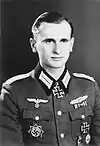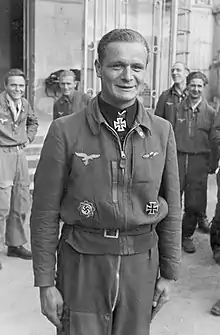German Cross
The War Order of the German Cross (German: Der Kriegsorden Deutsches Kreuz), normally abbreviated to the German Cross or Deutsches Kreuz, was instituted by Adolf Hitler on 28 September 1941. It was awarded in two divisions: in gold for repeated acts of bravery or military leadership; and in silver for distinguished non-combat war service. The German Cross in Gold ranked higher than the Iron Cross First Class but below the Knight's Cross of the Iron Cross, while the German Cross in Silver ranked higher than the War Merit Cross First Class with Swords but below the Knight's Cross of the War Merit Cross with Swords.[2]
| German Cross Deutsches Kreuz | |
|---|---|
  German Cross in Gold (left) and Silver (right) | |
| Type | Military Order |
| Awarded for | Gold: for repeated exceptional acts of bravery or troop leadership Silver: for continued distinguished acts of service in the war effort |
| Presented by | Nazi Germany |
| Eligibility | Military personnel |
| Campaign(s) | World War II |
| Status | Obsolete |
| Established | 28 September 1941 |
| Total | ~24,204 in Gold ~ 1,114 in Silver[1] |
 German Cross in Silver, Gold, and with Diamonds. Post-war de-nazified versions below. | |
| Precedence | |
| Next (lower) | Iron Cross (1939) 1st Class Clasp to the Iron Cross, 1st Class War Merit Cross 1st Class with Swords |
Eligibility
The German Cross was issued in two versions: gold and silver (the color of the laurel wreath around the swastika). The gold version was awarded to military personnel for repeated acts of bravery in combat, or of military leadership, with 6–8 acts as a rule of thumb.[3] The silver version was awarded for multiple distinguished services in the war effort and was considered a continuation of the War Merit Cross with swords. Where a recipient had been awarded both the silver and gold versions, only the gold version was authorized for wear.[4]
Article three of the law governing the German Cross states that to qualify for the German Cross in gold or silver, the recipient must be a holder of the Iron Cross (1939) 1st Class or Clasp to the 1914 Iron Cross 1st Class, or the War Merit Cross 1st Class with Swords.[5] The award of the German Cross was not a prerequisite for the award of the Knight's Cross of either the Iron Cross or War Merit Cross, and the German Cross could be awarded to Knight's Cross holders.[6]
While civilians were not eligible, awards could be made to members of uniformed formations including the police and railway workers.[7]
From 30 August 1944, recipients of the gold class of the Close Combat Clasp were normally also awarded the German Cross in gold, without the need for further justification,[8][9] although the additional award was not made in all cases.[10]
While estimates vary, approximately 24,204 gold and 1,114 silver crosses were awarded.[1][11]
Appearance
The order consists of a star badge, containing a swastika. It had a diameter of 6.5 cm and was worn on the right-hand side of the tunic.[2]
From June 1942 the gold version was officially available in cloth form, for easier wear on the combat uniform.[6] This had the same dimensions as the original decoration, with the wreath circling the swastika, the only metal part of the badge. The backing cloth reflected the arm of service: field grey for the army, or navy dark blue or air force pale blue.[7]
Twenty specimen copies of a special grade, the German Cross in Gold with Diamonds, were manufactured in 1942, but this grade was never formally instituted or bestowed.[7]
1957 version
The wearing of Nazi-era decorations was banned in Germany after the war, as was any display of the swastika. In 1957, the Federal Republic of Germany authorized the wearing of alternative de-nazified replacement versions of a number of war decorations. These included the German Cross, with the swastika replaced by a representation of the Iron Cross for the gold division, and the War Merit Cross with Swords for the silver division. Qualifying members of the Bundeswehr wore the award on their ribbon bar, represented by a small replica of the decoration on a field grey ribbon.[12]
 Award certificate: German Cross in Gold to Count Claus von Stauffenberg 8 May 1943
Award certificate: German Cross in Gold to Count Claus von Stauffenberg 8 May 1943 Award of a Marine (submarine crew) with the German Cross in Gold (1942)
Award of a Marine (submarine crew) with the German Cross in Gold (1942) Worn on chest pocket of the field blouse (Captain Alfred Jaedtke, 1944)
Worn on chest pocket of the field blouse (Captain Alfred Jaedtke, 1944) Cloth version worn on Luftwaffe flight suit (Lieutenant Siegfried Lemke, 1944)
Cloth version worn on Luftwaffe flight suit (Lieutenant Siegfried Lemke, 1944) Worn on the field uniform by an Oberfeldwebel of the Großdeutschland Division in Central Russia, 1943
Worn on the field uniform by an Oberfeldwebel of the Großdeutschland Division in Central Russia, 1943 German Cross in Gold (cloth form)
German Cross in Gold (cloth form)
Recipients
Select recipients of both gold and silver grades included:
- Major Josef Gangl, 8 March 1945 (gold)
- SS-Gruppenführer and Lieutenant General of the Police Odilo Globocnik, 7 February 1945 (gold) & 20 January 1945 (silver)
- SS-Standartenführer Rudolf Lange, 6th of February 1945 (Gold) awarded posthumously by Adolf Hitler.
- SS-Gruppenführer Bruno Streckenbach, 15 December 1943 (gold)
- Major General Ernst Merk, 11 February 1944 (gold) & 6 July 1942 (silver)
- SS-Standartenführer and Colonel of the Police Walther Rauff, 7 February 1945 (gold) & 20 May 1943 (silver)
- General Felix Schwalbe, 7 December 1944 (gold) & 30 November 1943 (silver)
- Lieutenant General Bodo Zimmermann, 25 September 1944 (gold) & 15 February 1943 (silver)
- SS-Hauptsturmführer Alfred-Ingemar Berndt, 17 July 1943 (gold)
- SS-Sturmbannführer Wilhelm Mohnke, 26 December 1941 (gold)
- SS-Obersturmbannführer Fritz Knoechlein, 15 November 1942 (gold)
- Lieutenant General Walter Krupinski, 27 August 1942 (gold)
- First Lieutenant Franz Stigler, 1 October 1944 (gold)
- Luftwaffe Major Günther Specht, 25 November 1943 (gold) [13]
- General of the Artillery Helmuth Weidling, 23 June 1942 (silver)
Foreign recipients
In October 1942, eligibility for the German Cross in Gold was extended to the armed forces of allied countries on the same basis as awards to German forces.[6]
Select foreign recipients of the German Cross in Gold include:
- Belgium
- SS-Standartenführer Léon Degrelle, 9 October 1944
- Croatia
- Lieutenant Cvitan Galić, 23 June 1943
- 1st Lieutenant Mato Dukovac
- Estonia
- Senior Lieutenant Hando Ruus, 30 December 1944
- Finland
- General Erik Heinrichs, 17 August 1943
- Lieutenant General Jarl Lundqvist, 9 November 1943
- Lieutenant General Karl Lennart Oesch, 5 August 1944,
- SS-Obersturmführer Ulf-Ola Olin, 28 February 1945
- Italy
- Vice Admiral Luigi Sansonetti, 18 January 1942
- Marshal Ettore Bastico, 5 December 1942
- General Enea Navarini, 21 December 1942
- Colonel General Rino Corso Fougier ,18 January 1943
- Latvia
- Untersturmführer Kārlis Mūsiņš
- Standartenführer Vilis Janums, 1 March 1945
- Romania
- General Gheorghe Avramescu, 25 October 1942
- Major General Leonard Mociulschi, 25 October 1942
- Major General Ermil Gheorghiu, 11 February 1943
- Captain Nicolae Dabija, 10 February 1944
- Spain
- Major General Emilio Estéban Infantes y Martín, 9 April 1943
In all, some 26 non-German volunteers of the Waffen-SS from Belgium, Denmark, Estonia, Finland, Hungary, Latvia, Netherlands and Norway received the German Cross in Gold.
Nicknames
Colonel Hans von Luck called it "Hitler's fried egg", in response to its gaudiness.[14] Another name for the decoration was "The Party Reflector for the Near-Sighted" [15]
References
- Citations
- Lumsden 2001, pp. 27–28.
- Angolia 1976, pp. 327–334.
- Note: Littlejohn & Dodkins p 123 says 7–12 further acts.
- Littlejohn & Dodkins 1968, pp. 122–124.
- Reichsgesetzblatt 1941.
- Klietmann 1981, pp. 47–49.
- Littlejohn & Dodkins 1968, p. 123.
- Klietmann 1981, p. 106.
- Michaelis 2008, p. 29.
- Williamson 2002, p. 6.
- Note: Klietmann page 48 estimates 17,000 gold and 900 silver awards to the army and Waffen-SS alone.
- Littlejohn & Dodkins 1968, p. 225.
- Patzwall & Scherzer 2001, p. 450.
- Von Luck 1989.
- Fowler 1992.
- Bibliography
- Angolia, John (1976). For Führer and Fatherland: Military Awards of the Third Reich. R. James Bender Publishing. ISBN 0-912138-14-9.
- Fowler, EWW (1992). Nazi Regalia. Brompton Books Corp. ISBN 1-55521-767-2.
- Klietmann, Kurt-Gerhard (1981). Auszeichnungen des Deutschen Reiches. 1936–1945, 11 Auflage (in German). Motorbuch, Stuttgart. ISBN 3-87943-689-4.
- Littlejohn, David; Dodkins, Colonel C. M. (1968). Orders, Decorations, Medals and Badges of the Third Reich. R. James Bender Publishing, California. ISBN 978-0854200801.
- Lumsden, Robin (2001). Medals and Decorations of Hitler's Germany. Airlife Publishing Ltd, Shrewsbury. ISBN 978-1840371789.
- Von Luck, Hans (1989). Panzer Commander. Praeger Publishers, New York. ISBN 0-440-20802-5.
- Maerz, Dietrich (2009). The German Cross in Gold and Silver. B&D Publishing, Richmond, MI. ISBN 978-0-9797969-2-0.
- Michaelis, Rolf (2008). Deutsche Kriegsauszeichnungen 1939-1945 Heer - Waffen-SS - Polizei (in German). Winkelried Verlag, Leisnig. ISBN 978-3930849314.
- Patzwall, Klaus D.; Scherzer, Veit (2001). Das Deutsche Kreuz 1941 – 1945 Geschichte und Inhaber Band II [The German Cross 1941 – 1945 History and Recipients Volume 2] (in German). Norderstedt, Germany: Verlag Klaus D. Patzwall. ISBN 978-3-931533-45-8.
- Reichsgesetzblatt (2 October 1941). Teil I S. 593; (PDF). Retrieved 19 August 2014.
{{cite book}}:|work=ignored (help) - Williamson, Gordon (2002). World War II German Battle Insignia. Osprey Publishing. ISBN 1841763527.